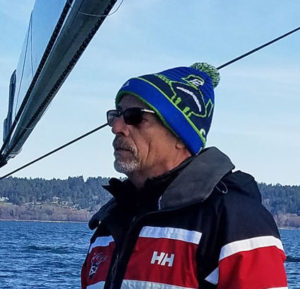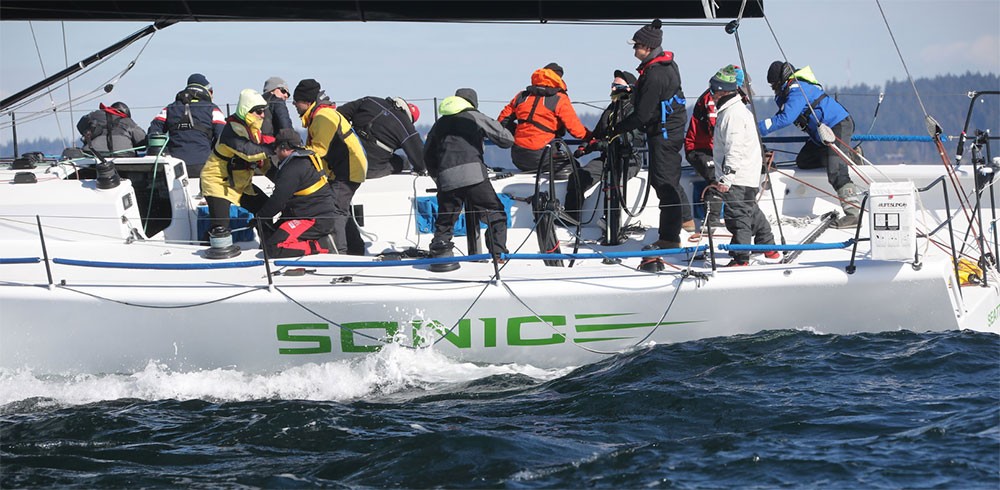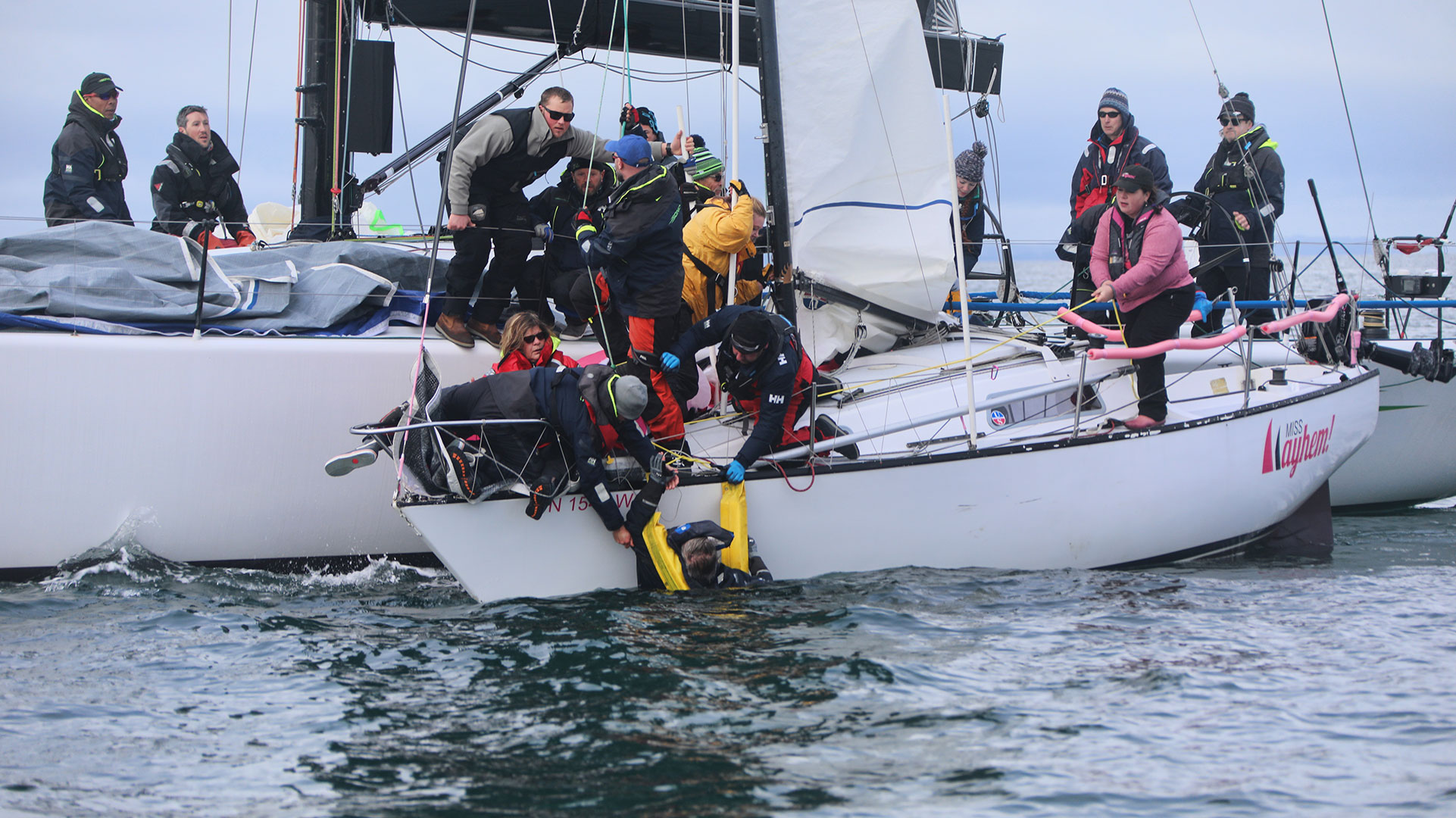Scott Smith Shares Overboard Rescue Experiences from TP 52 Sonic
 Editor’s Note: In the Pacific Northwest racing scene, it’s hard to think of a sailor more respected than Scott Smith. When I first started sailing with Scott a few years back on the TP 52, Glory, my first conclusion was simple: we were faster when he was aboard. Yet nuances of sail trim and rig set-up are not his only specialty; he’s also the consummate leader and communicator, and he instills a pragmatic approach to safety in all who sail with him. Scott is unequivocally one of the PNW’s best; and now more than ever, he’s invested in sharing his considerable experience and expertise.
Editor’s Note: In the Pacific Northwest racing scene, it’s hard to think of a sailor more respected than Scott Smith. When I first started sailing with Scott a few years back on the TP 52, Glory, my first conclusion was simple: we were faster when he was aboard. Yet nuances of sail trim and rig set-up are not his only specialty; he’s also the consummate leader and communicator, and he instills a pragmatic approach to safety in all who sail with him. Scott is unequivocally one of the PNW’s best; and now more than ever, he’s invested in sharing his considerable experience and expertise.
For the past two seasons, Scott has spent most of his time sailing with the Sonic team on their new-to-town TP 52. During this period, Scott, owner Marek Omillian, and the Sonic crew have been directly involved in two crew overboard recoveries, and neither swimmer was a Sonic sailor. While there are not good statistics about a regional increase in crew overboard incidents, there is no denying that numerous recent incidents indicate a growing concern about overboard prevention and response.
We are less than one week from the CYC Blakely Rocks Race which, for many, marks the start of the Puget Sound racing season; and for the Sonic crew, marks one year since their first crucial involvement in a successful overboard rescue. On the eve of the racing season, Scott wanted the entire community to benefit from the Sonic crew’s experience. Here’s Scott:
Experience, Learn, and Share
Hello, my name is Scott Smith and I have been racing sailboats in the Puget Sound region and different parts of the world for my entire life. I have been lucky enough to race and sail with some of the best sailors and people in our sport. In the last couple of years, I have decided that I want to find more avenues to share my knowledge because, well, I can’t take it with me. Plus, sailing has given me so much, I want give back and help others benefit from sailing safely and successfully.
I am writing this article because I’m concerned about the sudden increase of the dreaded call: “Man Overboard.” I can’t even remember of a man overboard in the last few decades; but in the last three years, I know of three separate overboard events—at PSSC 2018, CYC Blakely Rocks 2019, and Duwamish Head 2020. In the PSSC event, I was on a boat ready to assist, but since the swimmer was at a leeward mark there were already many boats on site. However, in the situations during Blakely Rocks and Duwamish Head, the Sonic team I am a part of was paramount in the rescue.
I feel we should share what we have learned in those two events. This includes the actual physical actions of a rescue, but also the increased understanding that we are basically on our own out there. This is no dig at the Coast Guard in any way, they have limited resources and are covering a huge area. They do everything they can every chance they get, and I am grateful they are there. Yet no matter what happens, they have to travel some distance to get to the site of a rescue, and that takes time. Because we sail in a cold environment (both air and water temperature), we need very quick responses to rescue a person from the water. This means our sailing fleet needs to be self-rescuing as a group, and so far this is what I have seen.
Rescue Facts
On Sonic, our typical crew is 12-15 people. We have two “voices”—the skipper and tactician. The tactician makes the calls for the maneuvers and the timing, with the skipper having the ability to make any sort of abort call. I am the tactician.

Blakely Rocks
In the 2019 Blakely Rocks Race, the wind was 16-18 knots. Sonic was a brand new program in its first full race in Seattle. We had practiced maybe five or six times, including man overboard practices. We were heading southwest just north of the Rocks, traveling at 13-14 knots with the full running A2 spinnaker, staysail, and main.
We had seen some crab pots ahead and had called for extra eyes looking forward. There was an object spotted on our line ahead that could not be immediately identified. The call was it’s a crab pot because it was reddish/orange. A few moments later the call was “Wait, that’s a person, Man Overboard!” Now remember, we are traveling fast. One of the bow team who was hiking in the stern immediately started to deploy the MOM unit (Man Overboard Module). Our course was right next to the swimmer, and the MOM unit deployed within 20-feet of her. You could see in her eyes the relief that she had been seen and would be rescued. This took about 30 seconds from the initial recognition that it was indeed a person in the water.
About that time, we started to hear “Man Overboard” on the VHF. We followed our processes discussed during our practices and debriefs, which include:
- Assign a spotter
- Turn down in course
- Leeward drop of the spinnaker
- Furl of the staysail
- Line check
- Motor on
- Motor in gear
- Alter course toward the swimmer
Once the motor was on, we headed up and tacked and saw two boats pulling the person out of the water. We continued to head back to assist if necessary and saw the boats scatter. They left our MOM unit in the water. We rescued our MOM unit like it was a person, and succeeded on our first pass. The total time was 11 minutes and 30 seconds. At first, this seemed like a long time. Had there not been other boats behind us who’d became aware of the situation and offered assistance, the person in the water would have been very cold and not much help during the rescue. After further review and discussions with other large boats, we eventually concluded that our response time was pretty good for a boat of our size in the given conditions.

Duwamish Head
Early in the Duwamish Head Race this year, the wind was very light—5 knots and flat water. Most of our crew were sitting to leeward up by the shrouds when we heard the call of “Man Overboard.” It took us a bit to locate the vessel and person in trouble. They called us by name as the closest boat, but they were right in our blind spot under the foot of the kite.
As soon as we saw them, we followed our procedures. However, this was different than the last rescue. The person was in the water, but hanging on to the side of their San Juan 24. We made the call to do a leeward drop, line check, motor start, and head toward the boat.
En route, we decided to raft and board three Sonic crew members to pull the person aboard. We saw people on their bow trying to get the Life Sling on. Our bow man prepped his halyard with the pit and grinders prepping the tail. Then, two of our larger guys boarded and grabbed the person and could not drag him aboard.
Our team tried to get the Life Sling properly set but he had a death grip on the rail with his arms over his head. There was no way he was going to let go, and this meant the Life Sling wasn’t any help pulling him up. So our bow guy stepped over the side of their boat and was lowered down in his harness, into the water at the level of the person hanging on. He bear-hugged him and, between he and our grinders, both men were hoisted up onto the bow. That took between 5:30 and 6 minutes from the moment we started the spinnaker drop.
We are lucky enough to have a medical person on board. This person checked out the soaking wet swimmer and confirmed all was OK, that he was just exhausted and cold. It was decided that the Skip and Jan Anderson on the photo boat would take the person and a crew member back to shore. We continued to raft while assisting with the transfer of the people and gear bags, making sure they had wallets and keys to a car.
After the photo boat left, we helped the two people left onboard get sorted and cleaned up a bit as there were a little shaken up. Finally, when they had their motor going and were sorted out, we continued on our race. The total time was 12 minuted and 30 seconds. The person was hanging on to the side of the boat for about a total of 6:00. In this seemingly short time, he was physically shot and could hardly move once back on board. It is important to plan on possible panic and very little help or understanding from any person you are rescuing who is in the water.

Sonic’s Lessons and Takeaways
Some of what we’ve learned on Sonic may be things many of you have heard before. These items apply whether you’re on a 20-foot or 60-foot boat. I encourage everyone to use and teach this information in any possible way.
Items to Perform Weeks or Days Before the Racing Starts
- Confirm all safety equipment is current and in proper working condition. This means manually inflating all cartridge-type Life Jackets (LJs) overnight to check for leaks. Then check the cartridge dates and repack them. This sounds intimidating, but it’s pretty easy.
- The repack of an inflatable LJ is a good time to attach the required light and whistle. Please don’t do just the minimum: use a high-lumens-output light that exceeds the regulations. It should strobe and be a super-bright white. Imagine looking for someone at night where there are shoreline lights in the background. The super-bright flashing light is so much easier to see.
- Having the rest of the required safety gear on board seems easy and redundant, but going through it is necessary. Flares, first aid kit, horn, whistle, tapered plugs, etc. Storing this equipment in the same specific location in a easily recognized Tupperware-type container is reassuring and saves time in an emergency.
- Have at least one forward halyard long enough for the shackle-end to reach into the water at the stern while the tail can still be put on a winch. This idea is in some offshore racing regulations, which stipulate (I’m paraphrasing) that at least one halyard needs to reach the water and have a three-meter tail. If the local rules don’t require an extra long halyard, have a length of line with a shackle and eye made up and ready for deployment. You could even have it attached to a Life Sling while it’s stored.
Day of Racing
We always have a pre-race brief about the expected conditions, course, currents, and sail usage. At the end of the brief, we always review the current safety conditions onboard and on the water. This not only includes locations of the fire extinguishers, life jackets, life rafts (if on board), and first-aid kits; but also who’s in the climbing harness for rig and rescue situations. With a large crew there can be substitutes, and this is important.
During The Race
Have two VHF radios on: one down below monitoring channel 16 and the other on deck monitoring the channel for the racing.
On Hearing Man Overboard Call
- Announce to the crew there is a man overboard situation.
- Determine your proximity to the area of the distress call.
- Decide and announce whether your boat will be involved in any part of the rescue to the crew.
- At this point multiple things start to happen:
- Announce your intentions on the same channel as the distress call.
- Crew starts to look for the person in the water.
- Once spotted, one person becomes the spotter and stands near the helm and tactician to help with positioning.
- Other crew start to prep for dousing the forward sails.
- The skipper or tactician announces to the crew what the maneuvers will be, along with emphasizing doing one’s role. Sails down, lines out of the water, engine on, etc.
En Route to Rescue
- First and foremost, locate and get to the person in the water.
- Assess what you see or don’t see. Do you see the person in the water? Is there any flotation or locating gear near them? Are they separated from or attached to the boat? Is their boat under control or in a panic situation, and are their sails orderly or in disarray? Is it safe to get close or not? Is it safe to transfer crew to help or not?
- Do a preliminary visual and verbal-if-possible assessment of the condition of the person in the water.
- Skipper and tactician determine the approach plan to the swimmer or the boat. Typically you approach along the leeward side. Odds are, you will still have your main up.
- Announce the plan to the crew. For example: “The person in the water is conscious, but the conditions are sloppy and windy so it warrants a heaving line as our first step. We’ll follow with a Life Sling and halyard. Copy?”
Swimmer Rescue
- Toss a heaving line to drag the swimmer close to the boat. This is likely to be more necessary in windy conditions. Make sure your boat speed is slow—1 knot or less. Basically the person in the water is physically and mentally shot at this point and can’t hold the line if you have any speed.
- Unless you have an open transom, odds are you will not be able to lift the swimmer out of the water. That means having the Life Sling out and ready. This is where the extra long halyard or halyard extension is necessary. Using a forward halyard is our preferred way for a variety of reasons:
- We most likely still have a main sail up.
- The forward halyard works great as it holds the person next to the boat.
- Once at the lifeline height, it naturally swings him into the center of the deck.
- The forward halyard rescue often keeps the rescuers out of the cockpit, so the rest of the crew can control the boat.
- It takes too long to rig tackle on the end of the boom, and more coordination. Plus, when the boom is centered, it often places the person on top of many things like winches and steering. Not ideal.
- Get the swimmer to commit to the Life Sling. It’s harder than it sounds. They must slip their head and both arms through the sling and push their arms down so the sling hooks under their armpits. If they don’t do this, the sling will slide off.
- Once on board, immediately check the basics: breathing and heart condition. Then assess the next move, CPR, hypothermia response, immediate transfer with assist, or just get below with warm dry clothes and something warm to drink.
- Announce over the radio that the rescue was completed.
- Have everyone take a breath and regroup. This is important, and ensures that developing a plan for the next steps is done thoughtfully and with a clear head.
One Hand for the Boat, One Hand for Yourself
In summation on a personal note, I am concerned that there are too many in the sailing community that are either not remembering or not abiding by the old adage: One hand for the boat, one hand for yourself.
This is a basic rule of survival, one that should be reiterated during pre-race and safety briefs.On the other hand, these two incidents show the commitment of our sailing community. The responses were quick and well-attended by a number of boats. It makes one feel good that most everyone is attentive and ready to help in any way. We are a small community and need to be prepared, practiced, and ready to render assistance.
I hope these ideas will open the eyes of some and inspire more awareness of the need to prepare, practice emergency situations, and share rescue experiences for the overall education of our fleet. Remember, it can happen to any boat at any time!
Thanks for reading and good sailing.
Scott, Marek, and the Sonic crew are presently preparing for a Pac Cup run to Hawaii this summer.






